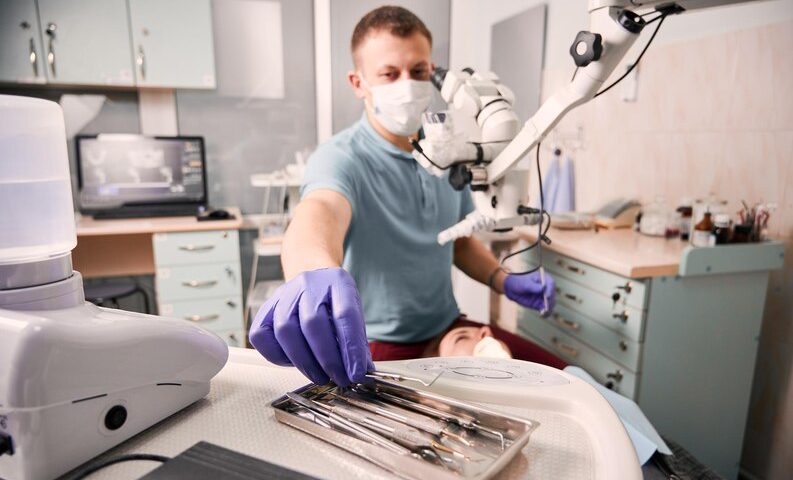
Dentist’s Hand Strength Tools
March 2, 2025
Dental Tool Market Trends
March 2, 2025With technology improvements, dental extraction has changed a great deal and so guarantee a better clinical result and patient experience. From old-fashioned forceps to cutting-edge digital technology, modern tools and techniques have made exactions more effective, quicker, and safer. From fundamental methods to advanced training and specialized instruments such XForceps that increase accuracy and lower dental practitioner stress, this blog will cover many aspects of dental extraction.
Extraction of teeth
Precision, expertise, and appropriate equipment all work together for a smooth tooth removal. Depending on the difficulty of the case whether it is an easy extraction or a more involved surgical operation the approach varies.
Simple extraction is done on obvious teeth that are easy to reach. First, an elevator is used to loosen the tooth before forceps are used to extract it. This approach calls for gentle treatment to reduce damage to neighboring tissues.
On the other hand, surgical extractions tackle more difficult to reach teeth such as impacted wisdom teeth. This approach entails creating a gum incision to expose the tooth and can call for splitting the tooth into smaller pieces to facilitate removal. Minimal patient distress and an easy recovery process come from right approach.
Training in Dental Extraction
Dentists need to have a lot of instruction in order to safely and effectively perform extractions. Theory knowledge coupled with practical experience guarantees that dental assistants and dentists are well prepared to negotiate many extraction situations.
Training courses highlight:
• Understanding oral anatomy is vital for risk-free extractions since knowledge of the arrangement of teeth, nerves, and neighboring tissue is required.
Learning how to handle every case is vital; from forceps use to surgical operations, mastering various extraction methods is required.
• Patient comfort maximization corrects anesthetic administration and kind handling techniques decrease suffering and speed recovery.
• Managing difficulties training teaches potential dangers including severe bleeding, infections, and nerve injury, therefore providing professionals with techniques to solve them.
Continued education and seminars enable dental practitioners to keep current with new technologies, therefore guaranteeing patients the top results.
Dental Extraction Treatment
When decay, infection, or trauma have made a tooth irreparable, dental extraction is usually the end solution. Careful planning and postoperative support help to speed healing and minimize problems.
The usual treatment procedure comprises:
1. Xray’s are done to evaluate the position and surrounding structures of the tooth prior to extraction.
2. Anesthesia administration Local anesthesia numbs the area, ensuring a painless procedure.
3. Extraction technique the dentist utilizes forceps and elevators or does a surgical extraction if required.
4. Instructions for post extraction preparation Patients are given guidelines for aftercare that include diet suggestions, swelling management, and repeat instruction.
Good post extraction treatment including staying away from hard foods, keeping oral hygiene, and using prescribed drugs will help much to speed the healing process and lower the possibility of problems.
Tooth Extraction Dental Assistant
By aiding dentists and supporting patients before, after, and during the operation, dental assistants ensure that extractions run smoothly.
They have to:
Preparing materials and tools—verifying ready availability of all required instruments like gauze, forceps, and elevators.
Helping dentists in anesthetic preparation and observing patient reactions therefore helps in anesthesia delivery.
• Patient education: Giving pre and post extraction guidance to guarantee correct healing and effective pain relief.
Maintaining infection control entails obeying exacting sterilization instructions to keep infections at bay.
Supporting the dentist while procedures are done handing tools, running suction equipment, and guaranteeing patient comfort throughout the extraction process.
Efficiency is improved and a relaxed experience for the patient as well as the dentist is given by a competent dental assistant.
X-Forceps: Revolutionizing Dental Extractions
Since they call for a lot of hand power and careful accuracy, traditional extraction ways may cause tiredness and probable errors. A groundbreaking invention, the XForceps improves extraction efficiency and reduces stress on dental staff.
XForceps benefits:
1. More Hand Strength Support: The design increases the dentist’s grip strength by 40%, therefore lowering exhaustion.
2. Built-in Pressure Sensor: Protects against damaging tissue and tooth cracks by minimizing the likelihood of excessive pressure being applied.
3. Integrated with camera system, a screen shows live pictures that raise accuracy and precision.
4. Lightweight and ergonomic layout relieve hand strain and therefore make straight work more comfortable.
5. Versatility in several sizes they come in many sizes to suit adult and pediatric operations and teeth removals.
Modern dental practices really need XForceps since it offers improved power, safety, and speed together with advanced features.
Conclusion
Advances in dental extraction technology have given professionals and patients alike less invasive, more efficient, and safer options. Dental experts can guarantee maximum patient care and lower physical strain by perfecting basic extraction methods and using state-of-the-art tools like XForceps. Embracing these changes will help to yield better results and a more pleasant dental experience for everybody as technologies keep to reshape the industry.

